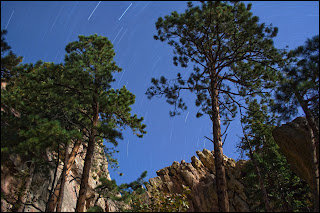our galactic neighbor, andromeda.
we are speeding towards each other! and in several billions of years andromeda and the milky way will collide. once the supermassive-black holes in the center of each galaxy get close enough they start to orbit each other. eventually, one will devour the other. it sounds scary, but its likely that not even a single star will collide in the process, given that there are a few lightyears between each one. that, and who knows what the state of the known universe will be like in billions of years. humans have only been around for 1/4000th~ of that time.
notice all the tiny red blots around the galaxy? each one is a nebula caused by a star that has exploded most likely via a supernova. it's the gas that made up the star but spread out in vast, unfathomable distances - no longer compressed under the intense gravity of the star. each one is comparable to the orion nebula under orion's belt. eventually they get to a point where it collapses again and becomes a new solar system! the universe is just a series of births and deaths of stars as well as the gravity that holds them all together.
next, see the white blob below andromeda? that's a separate, smaller galaxy. and that's relative, because that little guy has hundreds of millions of stars, each with the potential to have life on the planets as well as on the moons around the planets.
it should be noted that 99% of the stars you see in this picture are in the milky way, as we sit somewhere in the outer middle of its spiral arms. no matter where you look you're going to see stars - which is why when you look at "the milky way" you're actually looking towards the center of the galaxy, through layers of dust and stars. you can also easily tell which stars burn hot and which don't - the blues are scorchers and the yellow/red ones are old cooler ones just waiting to explode.
check out the high resolution, it's worth it:
http://apod.nasa.gov/apod/image/1001/M31
we are speeding towards each other! and in several billions of years andromeda and the milky way will collide. once the supermassive-black holes in the center of each galaxy get close enough they start to orbit each other. eventually, one will devour the other. it sounds scary, but its likely that not even a single star will collide in the process, given that there are a few lightyears between each one. that, and who knows what the state of the known universe will be like in billions of years. humans have only been around for 1/4000th~ of that time.
notice all the tiny red blots around the galaxy? each one is a nebula caused by a star that has exploded most likely via a supernova. it's the gas that made up the star but spread out in vast, unfathomable distances - no longer compressed under the intense gravity of the star. each one is comparable to the orion nebula under orion's belt. eventually they get to a point where it collapses again and becomes a new solar system! the universe is just a series of births and deaths of stars as well as the gravity that holds them all together.
next, see the white blob below andromeda? that's a separate, smaller galaxy. and that's relative, because that little guy has hundreds of millions of stars, each with the potential to have life on the planets as well as on the moons around the planets.
it should be noted that 99% of the stars you see in this picture are in the milky way, as we sit somewhere in the outer middle of its spiral arms. no matter where you look you're going to see stars - which is why when you look at "the milky way" you're actually looking towards the center of the galaxy, through layers of dust and stars. you can also easily tell which stars burn hot and which don't - the blues are scorchers and the yellow/red ones are old cooler ones just waiting to explode.
check out the high resolution, it's worth it:
http://apod.nasa.gov/apod/image/1001/M31










